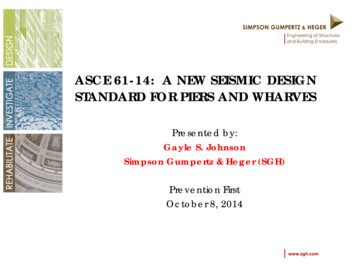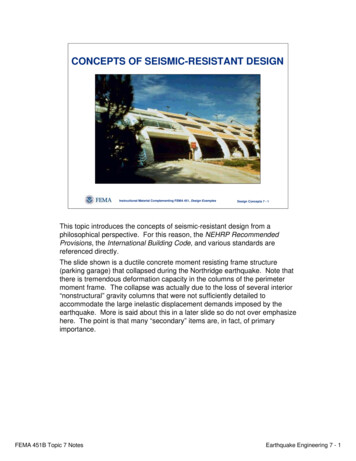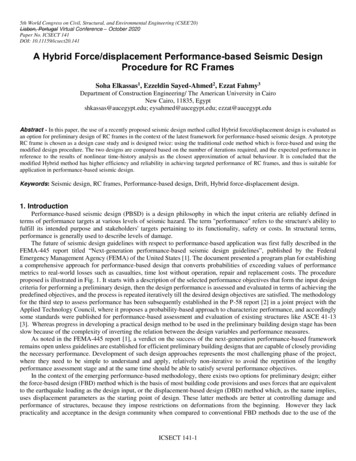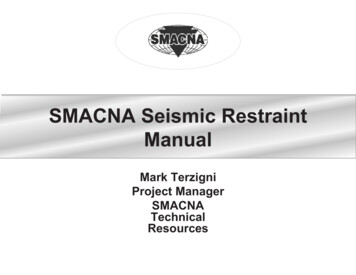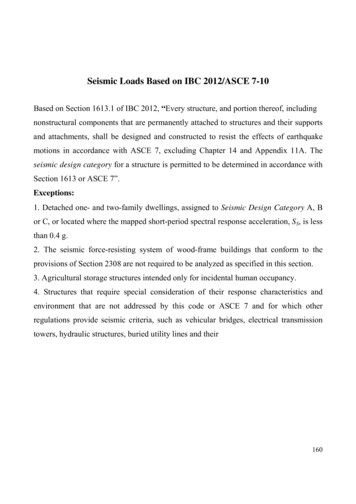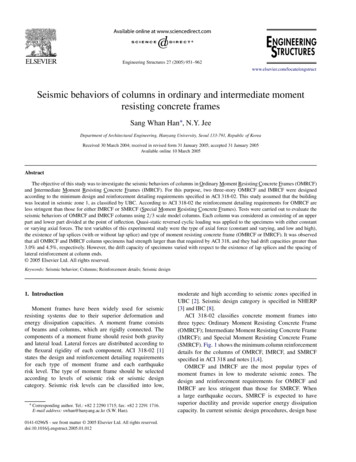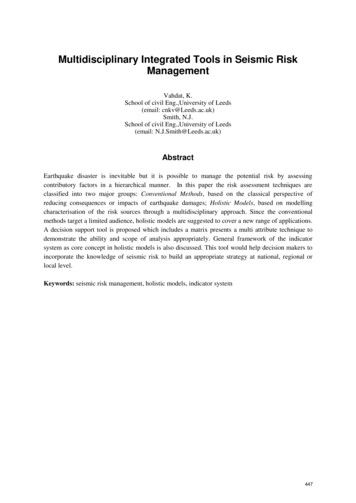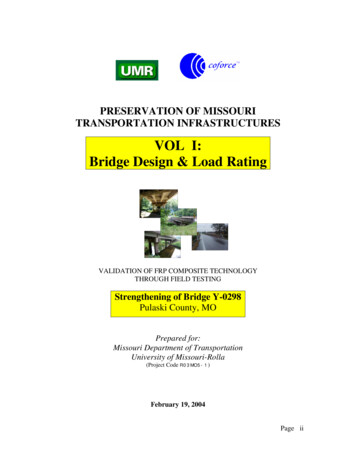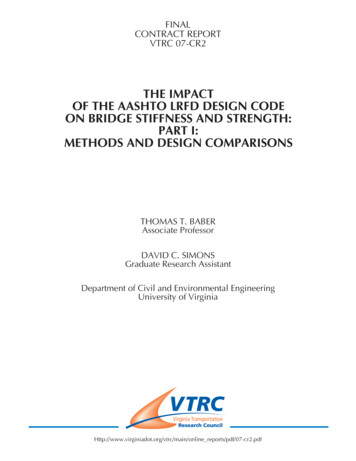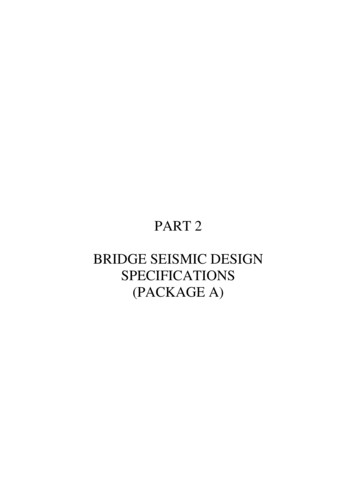
Transcription
PART 2BRIDGE SEISMIC DESIGNSPECIFICATIONS(PACKAGE A)
CHAPTER 55.1CHRONOLOGY OF BRIDGE SEISMICDESIGN SPECIFICATIONSIntroductionAlthough the DPWH has its own “Design Guidelines, Criteria and Standards for Public Works andHighways” which was first published in 1982, the seismic provisions of this guidelines has beenoutdated by recent earthquake events in the country and elsewhere. Owing to this deficiency in theDPWH Guidelines, the seismic design of bridges in the Philippines relies heavily on the “AmericanAssociation of State Highway and Transportation Officials (AASHTO) Standard Specifications forHighway Bridges” (17th Ed., 2002 using the load factor and allowable stress design) with the seismicdesign provisions practically guiding the design of new bridges in the Philippines. AlthoughAASHTO’s bridge design specifications have evolved to the load and resistance factor design (LRFD)and the displacement-based design procedures using probability theory and limit states, the DPWHstill applies the earlier version of AASHTO in seismic design. On the other hand, seismic design ofbridges in Japan focused on the performance-based approach which evolved based on the occurrencesof recent large earthquakes in Japan.This Chapter will describe the chronology of the development of the seismic design specifications forthe Philippines, Japan and the USA (Figure 5.2.1-1) based on large earthquake events that led to thecurrent state of the seismic design codes.5.2AASHTO Bridge Seismic Design Evolution (USA)The AASHTO highway bridge design specifications have evolved several times during the last 80years. The codes have developed from the allowable stress to load factor and to load and resistancefactor design. The seismic design provisions likewise progressed from the equivalent static lateralforce to the response spectrum method using force-based approach and recently the displacementbased approach. Since the Philippine bridge design practice basically adopts the AASHTO StandardSpecifications, the following will summarize the development of the AASHTO seismic designspecifications:5.2.1Early Design Code StagesThe first American Association of State Highway Officials (AASHO), later AASHTO, specificationsfor highway bridges was published in 1931, but it did not address the issue of seismic design until1940. However, although the 1941 AASHO code required that bridges be designed for earthquakeload, there is no explicit provision on how to determine the seismic load. It was in 1943 that theCalifornia Department of Transportation (Caltrans) developed various levels of equivalent static loadforces for seismic design of bridges combining such for the design of members using the workingstress design (WSD). However, it was not until 1961 that the edition of AASHO specifies earthquakeloading for use in the WSD approach following the Caltrans’ criteria.5-1
Japan Seismic DesignMajor EQ1920USA Seismic DesignPhilippine Seismic Design 1925 1st Bridge Design Code withSeismic Provision 1923 Kanto EQ,Japan 1929 Draft Detailed Reg. for RoadStructures1930 1939 Draft Specs for Highway Bridge 1931 AASHO Standard Specifications(kh 0.20)for Highway Bridges(1st Ed.), 1935 AASHTO (2nd Ed.)1940 1941 AASHO (3rd Ed.) 1944 AASHO (4th Ed.) 1949 AASHO (5th Ed.) 1948 Fukui EQ,Japan1950 1956 Specification for Steel Highway 1953 AASHO (6th Ed.) 1957 AASHO (7th Ed.) 1964 Specifications for Steel 1961 AASHO (8th Ed.) No specific seismic provision 1965 AASHO (9th Ed.) Basically follows AASHO/AASHTOBridge (kh 0.10-0.35, corrected byground type)1960 1964 Niigata EQ,– EQ load applied to WSDHighway BridgeJapan 1964 Design Specifications (kh 0.2,provisions 1969 AASHO (10th Ed.)kv 0.10)- Equivalent lateral static forcecoefficient method (C 0.02, 0.04,0.06) Prior to 1971, seismic designadopted lateral forces used inbuildings1970 1971 USA San 1971 Road Bridge Seismic DesignFernando EQ 1973 AASHTO (11th Ed.)Specs.(kh 0.1- 0.30, with corrections)- Unseating & liquefaction provision- Caltrans introduced new seismiccriteria 1977 AASHTO (12th Ed.) 1978 Miyagi EQ,- Adopted Caltrans seismic designJapan1980 1982 Central Japan 1983 AASHTO (13th Ed.) - ATC6 1980 Specs for Highway Bridges, V -Sea EQSeismic Design Guide Specs.Seismic Design(modified coefficient & deformationcheck) 1989 AASHTO (14th Ed.) 1982 DPWH Design GuidelinesCriteria- Uses J.P. Hollings Report kh 0.10(DL 0.5LL) 1989 USA LomaPrieta 1987 NSCP Vol. II Bridges (1st Ed.)1990 1990 North Luzon 1990 Specs for Highway Bridges, V -EQ. PhilippinesSeismic Design(Ductility, Ground Motion, kh 0.701.0, Residual Strength Check) 1992 AASHTO (15th Ed.) - Division I-A 1992 DPWH D.O.75 1994 AASHTO LRFD Bridge Design DPWH refers to AASHTO 16th Ed. 1996 AASHTO (16th Ed.) 1997 NSCP (2nd Ed.)Seismic Design 1993 Kushiro EQ,Specifications (1st Ed.)Japan- To follow AASHTO latest edition 1995 Specs. Restoration of HighwayBridges Damaged by Kobe EQ.(kh 1.5-2.0) 1994USANorthridge EQ- Based on AASHTO 16th Ed.seismic provision with 2-zonePhilippine seismic map (PGA0.2 & 0.4) 1996 Specs for Highway Bridges, V Seismic Design(Near field/inland ground motion fordynamic analysis) 1998 AASHTO LRFD (2nd Ed.) 2002 Specs for Highway Bridges, V Seismic Design(Seismic performance definition,dynamic analysis) 2002 AASHTO (17th Ed.) 2004 AASHTO LRFD (3rd Ed.) 2007 AASHTO LRFD (4th Ed.) 2004 DPWH Design Guidelines 2009 Guide Specs. for LRFD Bridge 2005 NSCP Vol II Bridges - Reprint 2010 AASHTO LRFD (5th Ed.) 2012 AASHTO LRFD (6th Ed.) NSCP 2011 LRFD Bridge Code 1995 Kobe EQ,Japan2000 2004 NiigataChuetsu EQ, JapanSeismic Design (1st Ed)Criteria (Draft)- Refer to AASHTO 1996 (16thEd.) Div. I-AEdition2010 2011 Tohoku DistrictPacific Coast EQ,Japan 2012 Specs for Highway Bridges, V Seismic Design(Effects of Tohoku Pacific Coastearthquake considered ) 2011 AASHTO LRFD Bridge SeismicDesign (2nd Ed.)5-2- Draft (on review) Revision of the DPWH DesignGuidelines, Criteria andStandards(To be implemented at the end of2012)2012)
Figure 5.2.1-1 Evolution of Seismic Bridge Design Specifications5.2.2 AASHO Elastic Design ApproachIn 1969, AASHO specifies anequivalent static lateral forcecoefficient for the design ofbridgesunderearthquakeloading (based on the Caltransprovisions). The coefficientsapplied to the dead load used todetermine the lateral forcedepends on the type offoundation (C 0.02 for spreadfootings with 400 kPa or morecapacity, C 0.04 for spreadfootings with less than 400 kPacapacity and C 0.06 for pilefoundation). Using the WSD, a33% increase in allowablestress is allowed for memberdesignduringearthquakeloading.SanSan FernandoFernando EarthquakeEarthquakeUSAUSA Feb. 9, 1971, San FernandoCaliforniaM 6.6SeismicSeismic DesignDesign altrans)(Caltrans)inin19731973 AASHTO adopted the Caltrans provisionsin the 1975 Interim SpecificationsEQ CFW where C ARS/ZF frame factorW dead loadA peak groundaccelerationR response spectraS soil amplification factorZ force reduction factorFigure 5.2.2-1 1971 San Fernando Earthquake Leadingto Caltrans Seismic ProvisionHowever, during the 1971 San Fernando earthquake, many highway bridges were either severelydamaged or collapsed despite the Caltrans seismic design provisions. The equivalent lateral forcecoefficients were found to be too low and columns lack ductility resulting to brittle failure.Following the lessons learned from the San Fernando earthquake, Caltrans developed the forcebased seismic design procedure to include the dynamic response characteristics of the bridge andthe effects of soil conditions on the seismic load.5.2.3AASHTO Force-Based Design Approach (WSD and LFD) In 1975, AASHTO adopted Caltrans seismic design approach and issued an interim specificationincreasing the amount of column transverse reinforcement and the girder seat widths to minimizethe risk of superstructure unseating in the event of a large earthquake. In this approach, the equivalent static force method was also used to calculate the designearthquake loading using the response coefficient C which is a function of the expected peakground acceleration, normalized acceleration response value for rock, soil amplification factor andforce reduction factor to account for column ductility. Factors for the structural system (singlecolumn or rigid frames) were also applied. Options to use WSD of the load factor strength design (LFD) were provided. However, the valuesfor the force reduction factors were not given making it difficult to determine the column ductilitydemand.5-3
SanSan FernandoFernando EarthquakeEarthquakeUSAUSASeismicSeismic DesignDesign SpecificationsSpecificationsseismic design forces (DivisionI-A). The deviation of thisFeb. 9, 1971, San FernandoCaliforniaM 6.61981 Seismic Design Guide Specificationswas issued based Applied TechnologyCouncil (ATC-6)AASHTO Standard Specifications forHighway Bridges incorporated DivisionI-A Seismic Design was issued in 1992.Provisions include:o Utilizing response spectra based onfour soil profile typeso Inelastic hinging of columns isconsidered using responsemodification factorso Transverse confine details for columnso Minimum support length introducedFigure 5.2.3-1 1971 San Fernando Earthquake Leadingto Revision of Design Specificationseditionfromthepreviouseditions include: (1) analysis ofstructures by response spectrummethod, (2) design accelerationspectrum based on soil types,(3)elasticmemberforcesderived from the combinationof two orthogonal horizontalseismic components, (4) use ofresponse modification factor(R)torepresentcolumnductility demand, and (5) ductile detailing of columns with minimum transverse reinforcement.The 500-year return period earthquake was used in determining the peak ground acceleration.5.2.4 AASHTO Force-Based Design Approach (LRFD)In 1994, the first edition of the “AASHTO LRFD Bridge Design Specifications” was publishedplacing earthquake loading under Extreme Event I limit state. Similar to the 1992 edition, theLRFD edition accounts for column ductility using the response modification R factors. The bridgeimportance became three levels – “critical”, “essential” and “others” where critical bridges mustremain open to all traffic after the design earthquake. Moreover, bridges are assigned to seismiczones to reflect the requirements for methods of analysis and bridge details. Similarly, the elasticseismic forces are calculated by the response spectrum analysis. In 2008, the “AASHTO LRFD Interim Bridge Specifications” was published to incorporate morerealistic site effects based on the 1989 Loma Prieta earthquake in California. Moreover, the elasticforce demand is calculated using the 1,000-year maps as opposed to the earlier 500-year returnearthquake. The design response spectrum in this interim specification is calculated using the mapsof peak ground acceleration, shortperiod (0.2s) design earthquakeresponsespectralaccelerationcoefficients and the 1-sec periodresponsespectralaccelerationcoefficient. The R-factor conceptOtherOther EarthquakesEarthquakesLoma Prieta, USA – Oct. 17,1989 (M 7.1)North Luzon, Philippines – July16, 1990 (M 7.9)North Ridge, USA – January 17,1994 (M 6.7)determineistheused AASHTOAASHTO LRFDLRFD BridgeBridgeDesignDesign SpecificationsSpecificationsForce-based approachusing strength reductionfactor (R-factor) to reduceelastic force demand AASHTOAASHTO LRFDLRFD SesimicSesimicBridgeBridge DesignDesignbased on the equal-displacementapproximationSeismicSeismic DesignDesign proach using displacementas a measure of earthquakedemand and damagestructuredeformations.Figure 5.2.4-1 Force-based and Displacement-basedAASHTO Specifications5-4
5.2.5AASHTO LRFD Seismic Bridge Design In 2009 (after the devastating earthquakes of 1989 Loma Prieta, 1990 North Luzon, 1994Northridge, 1995 Kobe, etc.), AASHTO published the “Guide Specifications for LRFD SeismicBridge Design” shifting the design focus from the force-based R-factor design approach to thedisplacement-based design approach to incorporate the displacement design principles for thedesign of ductile members. g use of the Rfactors for ductile column,inelastic displacement demandin short-period structures isincreased by a modificationfactor, use of four seismicdesign categories for analysis,design details and liquefactionconsideration,capacityprotection principles for columnandcap-beamcolumnconnections and use of nonlinear pushover analysis toevaluate displacement capacities.5.3NiigataNiigata EarthquakeEarthquakeJapanJapan June 16, 1964, Niigata RegionM 7.5SeismicSeismic DesignDesign ionsSpecificationswaswasrevisedrevisedinin19711971 Showa O-hashi Bridge Modified seismic coefficient methodincorporating natural period, soilcondition and bridge importanceEffect of ground liquefaction consideredUnseating prevention device introducedUnseating prevention devicePreventing girders from falling downUnseating caused by LiquefactionSource: PWRIFigure 5.2.5-1 Design considerations for soil liquefactionand unseating deviceJapan Bridge Seismic Design EvolutionAlthough the Philippine bridge design employs mainly the AASHTO Standard Specifications,reference is also made to the design procedures of the Japan Road Association (JRA) especially theanalysis and design of foundations. In this regard, the evolution of the seismic design of bridges inJapan is presented as follows:5.3.1 Early Stages of Bridge DesignThe first seismic designspecifications for bridges inJapan was established in 1925after the devastating effects ofthe 1923 Kanto earthquake inTokyo. Prior to the 1923 Kantoearthquake, seismic effect w
Edition 1994 USA Northridge EQ 1995 Kobe EQ, Japan 1994 AASHTO LRFD Bridge Design Specifications (1st Ed.) 1996 AASHTO (16th Ed.) 2002 AASHTO (17th Ed.) 2004 AASHTO LRFD (3rd Ed.) 2007 AASHTO LRFD (4th Ed.) DPWH refers to AASHTO 16th Ed. NSCP 2011 LRFD Bridge Code - Draft (on review) 1998 AASHTO LRFD (2nd .
